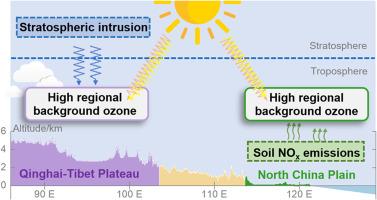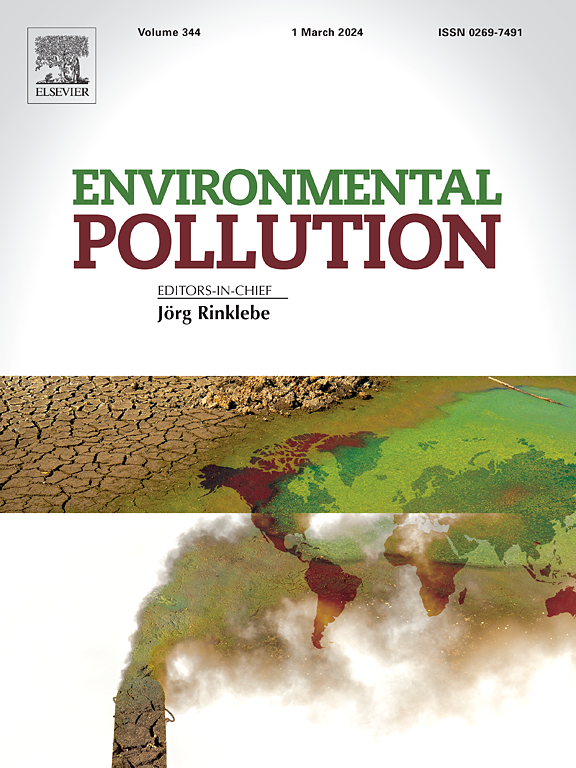Huge challenges of improving ozone pollution in China: High regional background ozone concentrations calculated from observational data
IF 7.3
2区 环境科学与生态学
Q1 ENVIRONMENTAL SCIENCES
引用次数: 0
Abstract
Understanding current regional background ozone concentrations can clarify their ability to meet air quality standards. In this study, the regional background ozone concentration was defined as the stable concentration of ozone caused by large-scale winds. Therefore, on the basis of an experimental equation, the national regional background ozone concentration was calculated via national hourly ozone concentration and wind speed observational data from 2015 to 2023. This study divided China into five regions according to the spatial distributions of climatic zones and regional background ozone concentrations. The regional background ozone concentration in China was low in the northeast (77.3 ± 5.7 μg/m3) and southeast monsoon (79.3 ± 5.2 μg/m3) regions and high in the southwest monsoon region (94.5 ± 8.0 μg/m3) and northern region (95.3 ± 7.1 μg/m3). The regional background concentration of the plateau region was considered high at the national level (99.6 ± 4.8 μg/m3). This study highlights that the regional background ozone concentration in plains is related to soil NOx, and that in plateaus is related to altitude (stratospheric intrusion and strong radiation). Cross-border transport from Southeast Asia contributed significantly to regional background ozone in Southwest China. Given the differences in regional background ozone concentrations, the ability to meet national air quality standards varies across regions. The plateau, northern, and southwest monsoon regions presented high regional background ozone concentrations, which indicates that these regions are under great pressure to reduce emissions.


改善中国臭氧污染的巨大挑战:由观测数据计算出的高区域本底臭氧浓度
了解当前的区域背景臭氧浓度可以澄清它们达到空气质量标准的能力。本研究将区域本底臭氧浓度定义为由大尺度风引起的稳定臭氧浓度。因此,在实验方程的基础上,利用2015 - 2023年全国逐时臭氧浓度和风速观测资料计算了全国区域背景臭氧浓度。根据气候带的空间分布和区域背景臭氧浓度,将中国划分为5个区域。中国区域背景臭氧浓度表现为东北低(77.3±5.7 μg/m3)和东南季风区低(79.3±5.2 μg/m3),西南季风区高(94.5±8.0 μg/m3)和北部高(95.3±7.1 μg/m3)。高原地区的区域背景浓度(99.6±4.8 μg/m3)在全国属于高水平。本研究强调平原区域本底臭氧浓度与土壤NOx有关,高原区域本底臭氧浓度与海拔高度(平流层入侵和强辐射)有关。来自东南亚的跨境运输对西南区域背景臭氧有显著贡献。鉴于区域背景臭氧浓度的差异,达到国家空气质量标准的能力因地区而异。高原、北季风区和西南季风区臭氧本底浓度较高,表明这些地区面临较大的减排压力。
本文章由计算机程序翻译,如有差异,请以英文原文为准。
求助全文
约1分钟内获得全文
求助全文
来源期刊

Environmental Pollution
环境科学-环境科学
CiteScore
16.00
自引率
6.70%
发文量
2082
审稿时长
2.9 months
期刊介绍:
Environmental Pollution is an international peer-reviewed journal that publishes high-quality research papers and review articles covering all aspects of environmental pollution and its impacts on ecosystems and human health.
Subject areas include, but are not limited to:
• Sources and occurrences of pollutants that are clearly defined and measured in environmental compartments, food and food-related items, and human bodies;
• Interlinks between contaminant exposure and biological, ecological, and human health effects, including those of climate change;
• Contaminants of emerging concerns (including but not limited to antibiotic resistant microorganisms or genes, microplastics/nanoplastics, electronic wastes, light, and noise) and/or their biological, ecological, or human health effects;
• Laboratory and field studies on the remediation/mitigation of environmental pollution via new techniques and with clear links to biological, ecological, or human health effects;
• Modeling of pollution processes, patterns, or trends that is of clear environmental and/or human health interest;
• New techniques that measure and examine environmental occurrences, transport, behavior, and effects of pollutants within the environment or the laboratory, provided that they can be clearly used to address problems within regional or global environmental compartments.
 求助内容:
求助内容: 应助结果提醒方式:
应助结果提醒方式:


